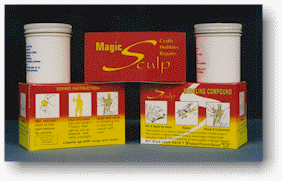Clay Wars: Episode I
The Air-Dry Menace
Special Edition
The following is hopefully the first in a series of articles reporting the goods, the bads, and the uglies about craft clays. I tried to take the most subjective view, so that you too can feel the deep emotions of CLAY. Purchasing information is included whenever possible. Enjoy! If you feel something needs to be added to any of the following (including new clays), or to be a part of Clay Wars Episode II, please contact me! Oh yeah, unlike some people we number our episodes in order.
Das Pronto (Margot) --
Das Pronto is my tool of choice--at least until I figure out how to work in resins.
I've only used Das in small portions up until now. The texture is interesting--it
reminds me quite keenly of working with shredded papier-mache as a child. Sandability
is excellent, particularly with a Dremel. It seems quite strong
though it seems to be brittle, if that's even a possible combination. I made a set
of breast plates from the stuff, which naturally popped off of the figure when dry.
I was able to san these tiny pieces without any support and achieved nice smooth
curves and sharp points. I was very, very pleased, though ended up covered with
white dust.
Instructions for use: It remains pliable for about 30 minutes and hardens
rapidly after that. I find it a bit difficult to get details into the stuff while
it's soft, so I tend to make the basic shape and then detail it later with a needle file
and the Dremel.
Conclusion: Don't use this stuff for any reason.
With the popping off, cracking, and brittleness, it's range of usage is quite
limited. Despite the cheapness (an appropriate pun) it's not worth the money.
Instead, buy the Magic Sculp right next to it on the aisle.
Magic Sculp (Baldwyn Chieh) --
First off, it's very similar to Milliput. My 16 oz box cost $9.99 (cheaper than
Milliput), and contained two plastic tubs containing the two parts of the putty. The texture is terrific for an epoxy putty! While
it's a little grainier than polymer clays, it's comparable to extra fine Milliput and much
better than regular Milliput. The other is that I did not have nearly the stickiness
problem that I do with Milliput. This stuff is much better to sculpt with, and cleans
up very nicely with just soap and water. Anyway, I checked it after it dried
overnight and can't scratch or chip it. I haven't tried sanding it, but expect it to
be similar to Milliput (easy, dusty, and messy).
Instruction for use: Both
parts are gray, with one slightly darker in shade. I measured out the recommended
amounts and started kneading, until just one color remained. Then, I began sculpting.
Conclusion: Anyone looking to sculpt something from a not-too-pricy air-drying
clay should definitely consider purchasing this overnight drying clay. This is much
better for beginners than both Milliput and Plumber's Putty. It is more durable and
easier to use than Milliput, and it has a much longer working time (about 12 hours) than
Plumber's Putty.
Try this for more:
http://www.magicsculp.com

I'm not sure where else to go, but www.magicsculp.com has a great gallery page.
Milliput (everyone) --
Well, I scoured, searched, mined, and dug through every possible source from everyone on
the CUSTOMIZE list, including the archives for the past 8 months. The following is what I
found: (nothing), but there is this:

For good examples of it's uses, check out Bill Burns' page, https://members.tripod.com/~billscustoms/index.htm
Mod'lers Mastic Plastic (Micromark Catalog Online) --
Mod'lers Mastic has the consistency and workability of modeling clay and can be molded,
sculpted, wrapped around forms or used for building-up and repairing figures, fittings,
ship hulls, airplane fuselages, dollhouse trim, etc. When cured, this two-part epoxy
compound simulates the density, texture and color of real metal, wood and semi-rigid
plastic. Parts A and B are co-extruded one around the other; to start the curing
cycle, simply cut off a piece and knead to a uniform color. Smooth with water.
Hardens in approximately 45 minutes; final cure after 24 hours. Each package contains 4.25
cubic inches. Working time: 20-25 minutes. Contains a fading blue die.
After final cure, has the density and appearance of semi-rigid light gray plastic.

I don't know anyone who's used this, so I can't link you.
Plumber's Putty (Leslie Hancock) --
The stuff I use comes in a plastic tube on a blister card, like our toys. The putty
itself is a two-part epoxy that looks like a big green Tootsie Roll with a yellowish-gray
center. It can be found in the paint section of most Wal-Marts. It stays in
place forever, as far as I can tell, and it does not crack or cause cracking in the paint.
It's extremely hard and tough, not like Super Sculpey at all. That's
why I like it so much, despite the short working time.
Instructions for use: Pinch off a bit of the roll (getting
some of each color) and knead it together to get the chemicals going. Continue
kneading until the color is a uniform gray, this is the signal to start sculpting... FAST!!!
In 10 minutes the clay becomes almost unworkable, and in 20 minutes it will be
hard enough to prime and paint. Don't do any sanding until it's 30 minutes old,
because it could gum up your Dremel bits or sandpaper.
Conclusion: Plumber's
Putty should be used by "expert" or fast-working sculptors, due to the short
working time. The stiffer texture and less maleability can help with small details
where Super Sculpey has that annoying tendency to stick to itself, lessening the overall
ability for detailing.
The preceding article was contributed by Trip "DarkMonkE" Somers, based on information gathered from just about everyone, but mainly Leslie Hancock, Baldwyn Chieh, and Tung Nguyen.